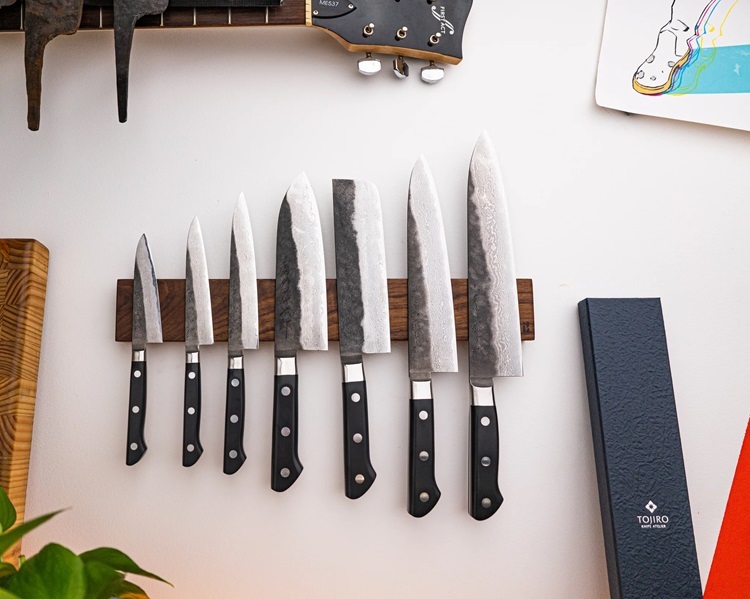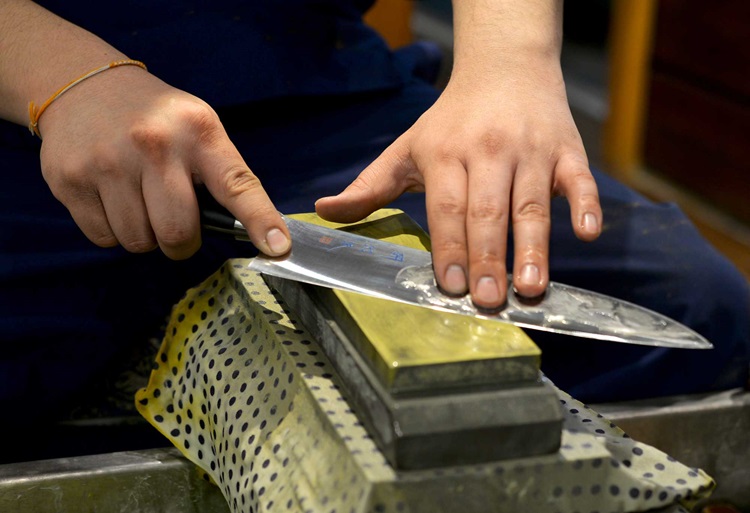If you have the privilege of owning a set of Japanese knives, then you are probably aware of the craftsmanship invested in achieving their precision and sharpness. However, the fine edge of the blade can become blunt and damaged if not secured properly. This is why you need storage specifically designed for Japanese knives to ensure the longevity and performance of these culinary treasures.
How Do You Store Japanese Kitchen Knives?

source: shopify.com
Knife Display Stand
One of the most popular choices for storing Japanese knives is a knife display. These racks feature strong magnets embedded in a strip or block, allowing knives to be securely attached to the surface. A multi-functional magnetic knife rack keeps knives safely organized, ensuring blades do not touch, preventing potential damage. The stands are typically made of wood, plastic, or metal. Wooden knife racks are a classic choice, providing a timeless and elegant look to your kitchen. They are available in various wood types, such as bamboo, walnut, or oak, and come in different designs, from countertop models to wall-mounted options, offering many benefits:
• Visibility and Aesthetics: Magnetic knife stands showcase your Japanese knives, making it easy to see and access each piece without rummaging through a drawer. This is particularly advantageous when you have an extensive collection. Magnetized racks accommodate knives of various sizes and shapes, providing a flexible storage solution.
• Safety and Accessibility: Knife racks keep the blades safely covered, reducing the risk of accidents and injuries in the kitchen. The vertical orientation of the racks allows for easy access, making it convenient for chefs to grab the desired knife quickly.
• Preservation of Sharpness: Unlike traditional knife blocks where blades can touch and potentially dull each other, a magnetic knife rack keeps the blades separated, preserving their sharp edges.
• Space Efficiency: These stands can be mounted on walls, saving valuable counter and drawer space. This is a crucial consideration for those with limited workspace.
• Customization and Size: Many knife stands come in modular designs, allowing users to customize the configuration based on the size and number of knives they own. Wall-mounted racks are ideal for saving countertop space and providing an organized and aesthetic display in your stylish kitchen.
• Hygiene and Maintenance: Unlike traditional knife racks, magnetized stands do not have slots or crevices where dirt and debris can accumulate. This makes them easy to clean and maintain. The open design also promotes air circulation around the blades, preventing moisture buildup that can lead to corrosion.
Knife Rolls and Bags
These storage solutions are ideal for transporting and protection. Choose rolls with individual slots and secure closures for safety. When selecting knife rolls or bags, consider the following key features:
1. Material: Choose durable materials like canvas or leather for longevity. Ensure the interior has soft, non-abrasive fabric to protect the blades.
2. Size and Capacity: Select a roll or bag with enough slots for your knives. Ensure a snug fit to prevent movement and potential damage during transport.
3. Additional Pockets: Look for extra compartments to store accessories such as honing rods or utensils. Consider models with zippered pockets for added security.
Saya (Sheaths)
Saya, or wooden sheaths, play a crucial role in protecting Japanese knives. Custom-fit wooden sheaths protect blades during storage. Ensure knives are dry before placing them in the saya to prevent moisture-related issues. Follow these tips for saya care:
Regular Inspection: Look for indications of wear, cracks, or damage. Replace damaged saya promptly to prevent accidents.
Cleaning: Wipe the inside of the saya with a dry cloth to remove any moisture. Avoid using water, as it can lead to mould and rust.
Cleaning and Care

source: korin.com
Japanese knives, especially high-carbon steel ones, are susceptible to rust. Here’s how to handle rust issues:
Gentle Cleaning Immediately After Use
Clean your knives immediately after use with a mild detergent and warm water. Dry them thoroughly to prevent any moisture-related issues. Use a soft cloth or sponge to gently remove surface rust. Apply a mixture of baking soda and water for stubborn rust spots.
Preventive Measures
Keep knives dry after use to prevent moisture buildup. Apply a thin layer of food-grade mineral oil to the blades regularly. This helps prevent corrosion and maintains the knife’s appearance.
Regular Honing and Sharpening
Maintain the knife’s edge with regular honing. Sharpen the blade as needed using whetstones or a honing rod.
Dos and Don’ts
Dos:
When using your knives, do so on soft cutting boards like wood or soft plastic. Avoid hard surfaces like glass or granite, as they can dull the blades quickly.
Handle your knives with care. Avoid using them for tasks they are not designed for, such as opening cans or prying. Don’t use the tip of the knife as a lever to lift or open things. This can lead to tip damage, affecting the knife’s functionality.
Avoid dishwasher cleaning. The high water pressure, heat, and harsh detergents can damage the blades and handles. Hand wash and dry them promptly instead.
Don’ts:
Never soak knives for extended periods. Prolonged exposure to water can lead to corrosion and damage to the handles. After using, make sure to wash and dry them right away.
Don’t use Japanese knives to cut through frozen foods or bones. These tasks can damage the blade and affect the knife’s overall performance.
Don’t overcrowd the kitchen knife stand. Ensure that each knife has its designated slot to prevent blades from touching.
Don’t store your knives in a damp or humid environment as moisture can lead to rust and corrosion. Keep them in a dry place.
Takeaway
Investing in Japanese knives is a commitment to culinary excellence, and proper storage and maintenance are essential to protect that investment. Whether using knife racks, rolls, bags, or saya, incorporating these practices into your routine will ensure that your knives remain sharp, rust-free, and ready for any culinary challenge. By following these guidelines, you can extend the life of your knives and enjoy the precision and craftsmanship they offer for years to come.

